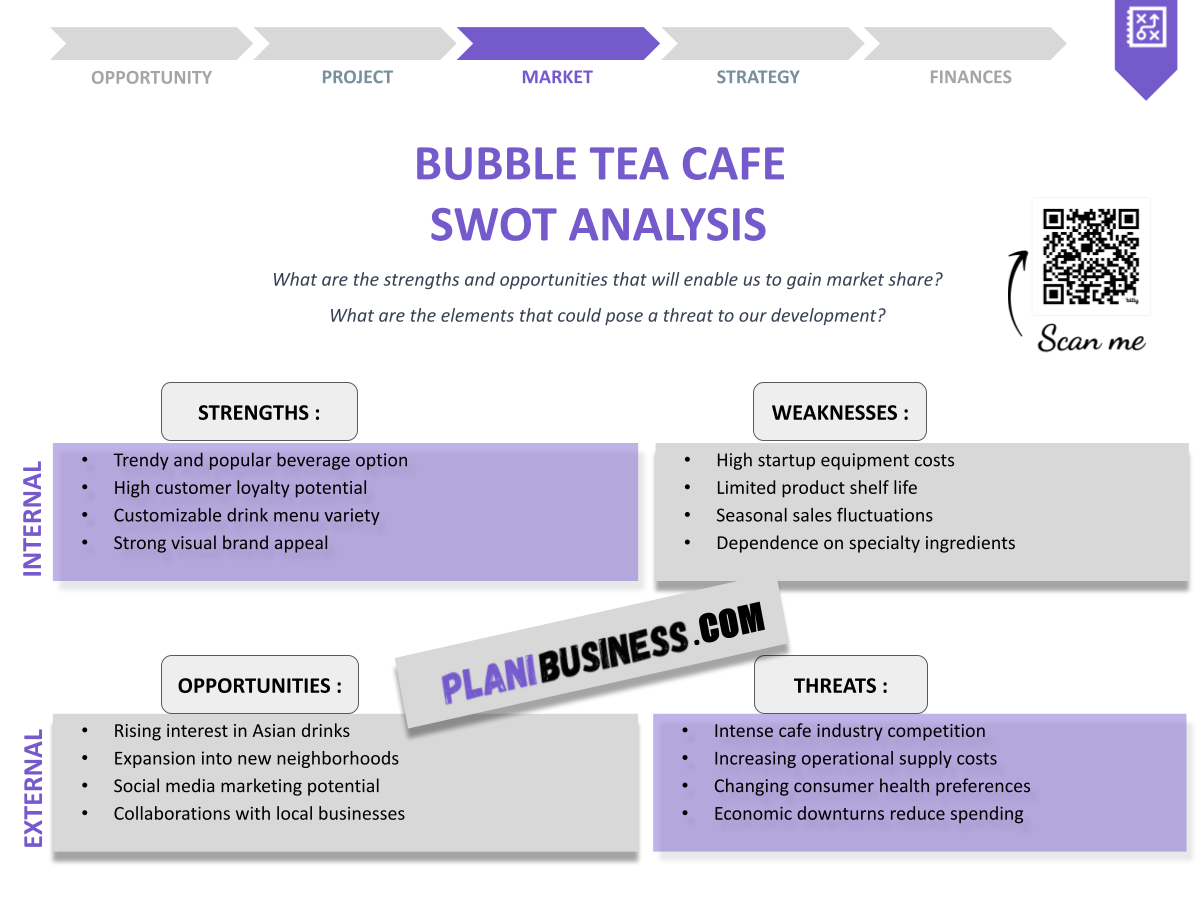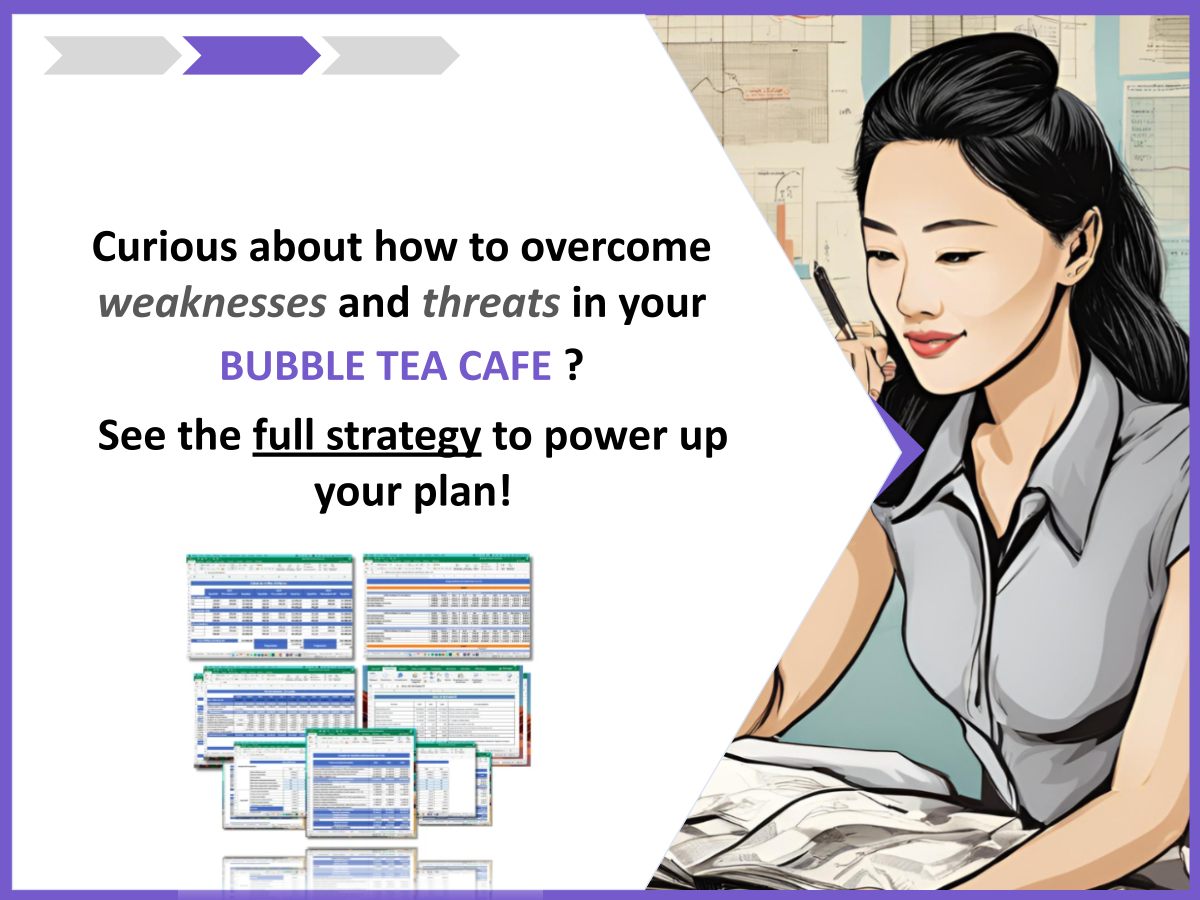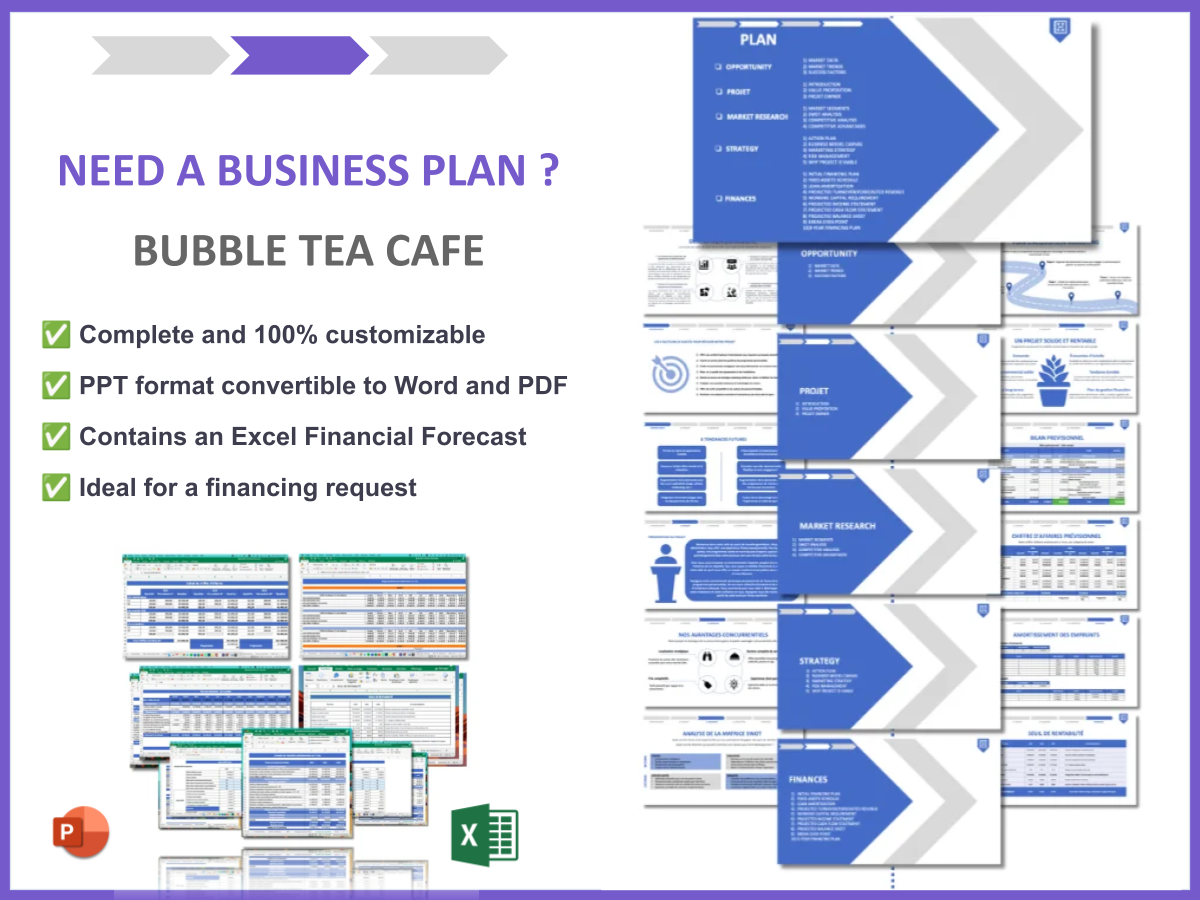Why Should You Have a SWOT Analysis for Your Bubble Tea Cafe?
Have you ever thought about why some bubble tea cafes thrive while others struggle to keep their doors open? You’re not alone! The bubble tea market is booming, but without a solid understanding of your business’s internal strengths and weaknesses, as well as the external opportunities and threats, you might find yourself lost in this vibrant yet competitive landscape.
A SWOT analysis for your bubble tea cafe helps you identify these critical factors, allowing you to strategically position your business for success. In simple terms, a SWOT analysis is a tool that helps you assess your business’s strengths, weaknesses, opportunities, and threats.
Here’s a quick rundown of what you can expect from this article:
- Understand the importance of SWOT analysis for your bubble tea cafe.
- Learn how to effectively write a SWOT analysis.
- Explore 10 real-world examples of SWOT analyses for bubble tea cafes.
- Gain insights into actionable strategies based on the analysis.
How Do You Write a SWOT Analysis for a Bubble Tea Cafe?
Writing a SWOT analysis is straightforward, but it requires honest reflection and a bit of research. To create an effective SWOT analysis for your bubble tea cafe, follow these steps:
Strengths
Your bubble tea cafe‘s strengths are what set you apart from competitors. Maybe you have a secret recipe for the best bubble tea in town or a cozy atmosphere that keeps customers coming back. Strong supplier relationships can also be a significant strength, ensuring you have high-quality ingredients at competitive prices. A loyal customer base can be your strongest asset, with patrons who rave about your bubble tea on social media. Unique offerings, like vegan or gluten-free options, can also attract niche markets, enhancing your brand’s appeal.
Weaknesses
Weaknesses are areas where your cafe may fall short. Perhaps your location isn’t ideal, or you lack brand recognition. A limited marketing budget can hinder your outreach efforts, making it hard to attract new customers. Staff training might be lacking, leading to inconsistent service quality that could frustrate patrons. Inventory management issues could lead to running out of popular ingredients during peak hours, resulting in lost sales.
Opportunities
Opportunities abound in the bubble tea market. The growing trend for health-conscious beverages can lead to new product offerings. Collaborating with local businesses for cross-promotions can expand your reach and attract new customers. Hosting events or workshops can create buzz and foster community engagement, making your cafe a local hub. Expanding your online presence through social media can help you reach a wider audience and boost sales.
Threats
The bubble tea market is competitive, with new cafes opening regularly, posing a threat to your customer base. Changes in consumer preferences can impact your sales if you’re not adaptable. Economic downturns can lead to reduced discretionary spending, affecting sales in cafes. Supply chain disruptions can threaten your ability to maintain product quality and availability.
SWOT Example N°1 for Bubble Tea Cafe
Let’s take a look at a hypothetical bubble tea cafe named “Bubble Bliss.” This example illustrates how a SWOT analysis can provide valuable insights for a bubble tea cafe.
| SWOT | Analysis |
|---|---|
| Strengths | Unique flavors, loyal customer base |
| Weaknesses | Limited marketing budget |
| Opportunities | Growing health trend |
| Threats | New competitors entering market |
- Unique flavors set it apart.
- Loyal customers provide a strong base.
- Limited budget hinders marketing.
- Increasing competition is a concern.
- Bubble Bliss has established a niche market with its unique flavors, but it needs to invest in marketing to stay ahead of competitors.
SWOT Example N°2 for Bubble Tea Cafe
Now, consider “Tea Time Delight.” This example showcases another approach to conducting a SWOT analysis for a bubble tea cafe.
| SWOT | Analysis |
|---|---|
| Strengths | Cozy atmosphere, great reviews |
| Weaknesses | Inconsistent staff training |
| Opportunities | Local partnerships |
| Threats | Economic downturns |
- Cozy atmosphere attracts customers.
- Positive reviews enhance reputation.
- Staff training needs improvement.
- Economic factors may affect sales.
- Tea Time Delight has a fantastic ambiance, but it must address staff training to maintain service quality during busy hours.
SWOT Example N°3 for Bubble Tea Cafe
Next, we explore “Bubble Wave.” This example demonstrates how a SWOT analysis can highlight key factors affecting a bubble tea cafe‘s success.
| SWOT | Analysis |
|---|---|
| Strengths | Eco-friendly packaging |
| Weaknesses | Limited seating |
| Opportunities | Expansion into delivery |
| Threats | Rising ingredient costs |
- Eco-friendly approach appeals to customers.
- Limited seating restricts customer flow.
- Delivery could boost sales.
- Rising costs pose a risk.
- Bubble Wave’s eco-friendly packaging is a big draw, but expanding its seating or delivery options could help it grow further.
SWOT Example N°4 for Bubble Tea Cafe
Let’s analyze “Tapioca Haven.” This example provides insights into how a SWOT analysis can inform business strategies for a bubble tea cafe.
| SWOT | Analysis |
|---|---|
| Strengths | Diverse menu |
| Weaknesses | High staff turnover |
| Opportunities | Seasonal promotions |
| Threats | Health trends shifting away from sugar |
- Diverse menu caters to various tastes.
- High turnover affects service quality.
- Seasonal promotions could attract new customers.
- Health trends may impact sales.
- Tapioca Haven’s diverse menu is a strength, but it must address staff turnover to ensure consistent service.
SWOT Example N°5 for Bubble Tea Cafe
Consider “Boba Bliss.” This example highlights how a SWOT analysis can help a bubble tea cafe navigate its business landscape effectively.
| SWOT | Analysis |
|---|---|
| Strengths | Strong online presence |
| Weaknesses | Limited physical location |
| Opportunities | E-commerce for products |
| Threats | Intense competition |
- Strong online presence drives traffic.
- Limited physical location restricts customer base.
- E-commerce can expand reach.
- Competition is fierce in the area.
- Boba Bliss leverages its online presence well, but it should explore e-commerce to mitigate the limitations of its physical location.
SWOT Example N°6 for Bubble Tea Cafe
Next, we look at “Sweet Tea Spot.” This example demonstrates how a SWOT analysis can provide insights into a bubble tea cafe‘s operational strategies.
| SWOT | Analysis |
|---|---|
| Strengths | Family-friendly atmosphere |
| Weaknesses | Outdated decor |
| Opportunities | Community events |
| Threats | Rising rent costs |
- Family-friendly vibe attracts patrons.
- Outdated decor may deter new customers.
- Community events can enhance visibility.
- Rent increases pose a financial threat.
- Sweet Tea Spot's family-friendly atmosphere is great, but updating the decor could attract a younger crowd.
SWOT Example N°7 for Bubble Tea Cafe
Let’s analyze “Tasty Tapioca.” This example illustrates how a SWOT analysis can reveal both challenges and advantages for a bubble tea cafe.
| SWOT | Analysis |
|---|---|
| Strengths | Unique marketing strategies |
| Weaknesses | Limited variety of drinks |
| Opportunities | Collaborations with influencers |
| Threats | Changes in consumer preferences |
- Creative marketing grabs attention.
- Limited drink variety can turn customers away.
- Collaborating with influencers can boost sales.
- Shifts in consumer tastes may impact offerings.
- Tasty Tapioca’s marketing is spot on, but expanding the drink menu could help retain customers.
SWOT Example N°8 for Bubble Tea Cafe
Next, we have “Boba Bonanza.” This example demonstrates how a SWOT analysis can inform strategic decisions for a bubble tea cafe.
| SWOT | Analysis |
|---|---|
| Strengths | Excellent customer service |
| Weaknesses | High ingredient costs |
| Opportunities | Pop-up events |
| Threats | New regulations |
- Customer service is a strong point.
- High costs could squeeze margins.
- Pop-up events can attract new customers.
- Regulatory changes may require adjustments.
- Boba Bonanza excels in service, but it needs to manage costs effectively to maintain profitability.
SWOT Example N°9 for Bubble Tea Cafe
Consider “Bubblelicious.” This example showcases how a SWOT analysis can provide insights into the operational aspects of a bubble tea cafe.
| SWOT | Analysis |
|---|---|
| Strengths | Innovative flavors |
| Weaknesses | Poor online reviews |
| Opportunities | Expanding into new markets |
| Threats | Economic instability |
- Innovative flavors attract curious customers.
- Poor reviews can harm reputation.
- New market expansion offers growth potential.
- Economic factors may limit customer spending.
- Bubblelicious’s innovative flavors are a hit, but improving online reviews is crucial for reputation.
SWOT Example N°10 for Bubble Tea Cafe
Lastly, we have “Charming Chai.” This example illustrates how a SWOT analysis can help a bubble tea cafe understand its market position.
| SWOT | Analysis |
|---|---|
| Strengths | Warm community feel |
| Weaknesses | Limited marketing efforts |
| Opportunities | Seasonal menu changes |
| Threats | Increased competition |
- Community feel fosters loyalty.
- Limited marketing hampers growth.
- Seasonal menu can attract customers.
- Competition is on the rise.
- Charming Chai has a great community vibe, but it should enhance marketing to keep up with competitors.
Conclusion
In summary, conducting a SWOT analysis for your bubble tea cafe is essential for understanding your position in the market. By identifying your strengths, weaknesses, opportunities, and threats, you can strategically plan for growth and success. Don’t wait any longer—start crafting your SWOT analysis today to elevate your bubble tea business!
If you’re looking for a comprehensive tool to help you get started, check out this business plan template for Bubble Tea Cafe. Additionally, for further insights, explore our articles on How to Develop a Bubble Tea Cafe? and How to Build a Bubble Tea Cafe Marketing Plan? With Example.
FAQ
What is a SWOT analysis?
A SWOT analysis is a strategic tool used to identify the strengths, weaknesses, opportunities, and threats related to a business.
Why is a SWOT analysis important for a bubble tea cafe?
It is crucial for understanding the internal and external factors that can impact the success of your bubble tea cafe.
How often should I conduct a SWOT analysis?
It is advisable to perform a SWOT analysis at least once a year or whenever there are significant changes in your business environment.
Can a SWOT analysis help with marketing strategies?
Definitely! By identifying your strengths and opportunities, you can create effective marketing strategies tailored to your target audience.
What are some common weaknesses in bubble tea cafes?
Common weaknesses may include high staff turnover, limited marketing budgets, or inconsistent product quality.
How can I use opportunities identified in a SWOT analysis?
Opportunities can guide your product development, marketing strategies, and potential business expansion.
What threats should bubble tea cafes be aware of?
Threats include rising competition, changing consumer preferences, and economic downturns that may affect spending.
Is a SWOT analysis a one-time activity?
No, it should be a recurring process to adapt to the evolving market and your business growth.
How can I involve my team in the SWOT analysis?
Encouraging team brainstorming sessions can provide diverse perspectives on the SWOT analysis components.
What is the best way to present my SWOT analysis?
A clear table format with concise points for each quadrant makes it easy to understand and discuss.
How can I improve my bubble tea cafe based on SWOT analysis findings?
Utilizing the insights from your SWOT analysis can help you make informed decisions, enhance customer experience, and adapt your business strategies effectively.







